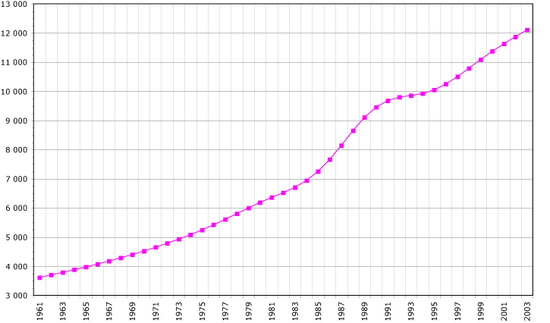Demographics of Malawi
2007 Schools Wikipedia Selection. Related subjects: African Geography
Malawi derives its name from the Maravi, a Bantu people who came from the southern Congo about 600 years ago. On reaching the area north of Lake Malawi, the Maravi divided. One branch, the ancestors of the present-day Chewas, moved south to the west bank of the lake. The other, the ancestors of the Nyanjas, moved down the east bank to the southern part of the country.
By AD 1500, the two divisions of the tribe had established a kingdom stretching from north of the present-day city of Nkhotakota to the Zambezi River in the south, and from Lake Malawi in the east, to the Luangwa River in Zambia in the west.
Migrations and tribal conflicts precluded the formation of a cohesive Malawian society until the turn of the 20th century. In more recent years, ethnic and tribal distinctions have diminished. Regional distinctions and rivalries, however, persist. Despite some clear differences, no significant friction currently exists between tribal groups, and the concept of a Malawian nationality has begun to take hold. Predominantly a rural people, Malawians are generally conservative and traditionally nonviolent.
The Chewas constitute 90% of the population of the central region; the Nyanja tribe predominates in the south and the Tumbuka in the north. In addition, significant numbers of the Tongas live in the north; Ngonis--an offshoot of the Zulus who came from South Africa in the early 1800s--live in the lower northern and lower central regions; and the Yao, who are mostly Muslim, predominate in the Southern Region of the country and live in a wide band from Blantyre and Zomba north to Lake Malawi and east to the border with Mozambique. Bantus of other tribes came from Mozambique as refugees.
Europeans and Asians also live here. Most Europeans are British and Portuguese from Mozambique, and Asians are mostly Indians.
Population: 10,385,849
note: estimates for this country explicitly take into account the effects of excess mortality due to AIDS; this can result in lower life expectancy, higher infant mortality and death rates, lower population and growth rates, and changes in the distribution of population by age and sex than would otherwise be expected (July 2000 est.)
Age structure:
0-14 years: 45% (male 2,335,440; female 2,324,012)
15-64 years: 52% (male 2,671,580; female 2,766,560)
65 years and over: 3% (male 117,932; female 170,325) (2000 est.)
Population growth rate: 1.61% (2000 est.)
Birth rate: 38.49 births/1,000 population (2000 est.)
Death rate: 22.44 deaths/1,000 population (2000 est.)
Net migration rate: 0 migrant(s)/1,000 population (2000 est.)
Sex ratio:
at birth: 1.03 male(s)/female
under 15 years: 1 male(s)/female
15-64 years: 0.97 male(s)/female
65 years and over: 0.69 male(s)/female
total population: 0.97 male(s)/female (2000 est.)
Infant mortality rate: 122.28 deaths/1,000 live births (2000 est.)
Life expectancy at birth:
total population: 37.58 years
male: 37.2 years
female: 37.98 years (2000 est.)
Total fertility rate: 5.33 children born/woman (2000 est.)
Nationality:
noun: Malawian(s)
adjective: Malawian
Ethnic groups: Chewa, Nyanja, Tumbuka, Yao, Lomwe, Sena, Tonga, Ngoni, Ngonde, Asian, European
Religions: Protestant 55%, Roman Catholic 20%, Muslim 20%, indigenous beliefs
Languages: English (official), Chichewa (official), other languages important regionally
Literacy:
definition: age 15 and over can read and write
total population: 58%
male: 72.8%
female: 43.4% (1999 est.)
- See also : Malawi
Algeria • Angola • Benin • Botswana • Burkina Faso • Burundi • Cameroon • Cape Verde • Central African Republic • Chad • Comoros • Democratic Republic of the Congo • Republic of the Congo • Côte d'Ivoire (Ivory Coast) • Djibouti • Egypt • Equatorial Guinea • Eritrea • Ethiopia • Gabon • The Gambia • Ghana • Guinea • Guinea-Bissau • Kenya • Lesotho • Liberia • Libya • Madagascar • Malawi • Mali • Mauritania • Mauritius • Morocco • Mozambique • Namibia • Niger • Nigeria • Rwanda • São Tomé and Príncipe • Senegal • Seychelles • Sierra Leone • Somalia • South Africa • Sudan • Swaziland • Tanzania • Togo • Tunisia • Uganda • Western Sahara (Sahrawi Arab Democratic Republic) • Zambia • Zimbabwe
Dependencies and other territories
British Indian Ocean Territory • Canary Islands • Ceuta • Melilla • Madeira Islands • Mayotte • Réunion • St. Helena
